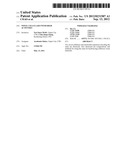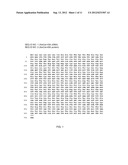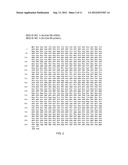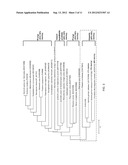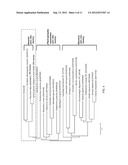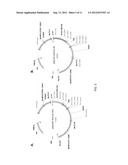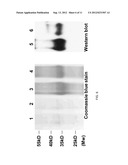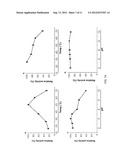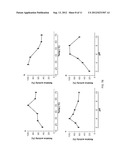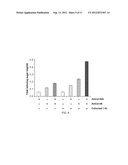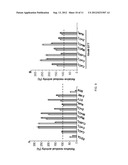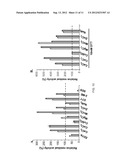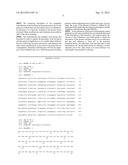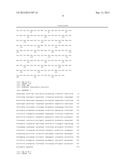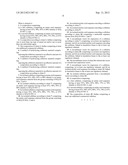Patent application title: NOVEL CELLULASES WITH HIGH ACTIVITIES
Inventors:
Yu-Chan Chao (Taipei City, TW)
Chia-Jung Chang (Kaohsiung-Hsien, TW)
Assignees:
Academia Sinica
IPC8 Class: AC12P1900FI
USPC Class:
435 72
Class name: Chemistry: molecular biology and microbiology micro-organism, tissue cell culture or enzyme using process to synthesize a desired chemical compound or composition preparing compound containing saccharide radical
Publication date: 2012-09-13
Patent application number: 20120231507
Abstract:
Two novel cellulases and nucleotide sequences encoding the same are
disclosed. Also disclosed are compositions and methods for using the same
for hydrolyzing cellulosic waste materials.Claims:
1. A composition comprising: (a) a first cellulase, comprising an amino
acid sequence having at least 95%, 90%, 85% or 80% identity to SEQ ID NO:
2; and (b) a second cellulase, comprising an amino acid sequence having
at least 95%, 90%, 85%, 80%, 75% 70%, or 65% identity to SEQ ID NO: 4.
2. A composition according to claim 1, further comprising one or more than one type of metal ion and/or one or more than one antioxidant agent.
3. The composition of claim 1, further comprising at least one additional commercial cellulase.
4. A method of hydrolyzing cellulosic material comprising: exposing the cellulosic material to an effective amount of a composition according to claim 1.
5. A method of hydrolyzing cellulosic material comprising: exposing the cellulosic material to an effective amount of a composition according to claim 2.
6. A method of hydrolyzing cellulosic material comprising: exposing the cellulosic material to an effective amount of a composition according to claim 3.
7. An isolated cellulase comprising an amino acid sequence having at least 95%, 90%, 85% or 80% identity to an amino acid sequence selected from the group consisting of SEQ ID NOs: 2 and 4.
8. An isolated cellulase according to claim 7, comprising an amino acid sequence having at least 95%, 90%, 85% or 80% identity to SEQ ID NO: 2.
9. An isolated cellulase comprising an amino acid sequence having at least 95%, 90%, 85%, 80%, 75% 70%, or 65% identity to SEQ ID NO: 4.
10. An isolated cellulase according to claim 7, comprising the amino acid sequence selected from the group consisting of SEQ ID NOs: 2 and 4.
11. An isolated nucleic acid sequence encoding a cellulase according to claim 7.
12. An isolated nucleic acid sequence encoding a cellulase according to claim 9.
13. An isolated nucleic acid sequence encoding a cellulase according to claim 10, comprising a nucleotide sequence chosen from SEQ ID NOs: 1 and 3.
14. A recombinant vector for expression of a cellulase according to claim 7, comprising: (a) at least one regulatory element; and (b) an isolated nucleic acid sequence encoding the cellulase, linked in translation frame to the at least one regulatory element.
15. A recombinant vector for expression of a cellulase according to claim 10, comprising: (a) at least one regulatory element; and (b) an isolated nucleic acid sequence encoding the cellulase, linked in translation frame to the at least one regulatory element.
16. The recombinant vector of claim 14, wherein the vector is a baculovirus expression vector.
17. A recombinant vector for expression of a cellulase, comprising: (a) at least one regulatory element; and (b) an isolated nucleic acid sequence according to claim 13, linked in translation frame to the at least one regulatory element.
18. An isolated cellulase generated from a recombinant vector according to claim 14.
19. A composition comprising: (a) a first cellulase, comprising an amino acid sequence having at least 95%, 90%, 85%, 80%, 75% or 70% identity to SEQ ID NO: 2; and (b) a second cellulase, comprising an amino acid sequence having at least 95%, 90%, 85%, 80%, 75%, 70% or 65% identity to SEQ ID NO: 4.
20. The composition of claim 19, further comprising at least one additional commercial cellulase.
Description:
FIELD OF THE INVENTION
[0001] The present invention relates generally to cellulases, and more specifically to novel cellulases with high activities.
BACKGROUND OF THE INVENTION
[0002] Cellulases, cellulose (highly-polymerized β-1,4-glucan)-degrading enzymes, generally include cellobiohydrolase (targeting mainly crystalline cellulose) and endo-1,4-β-endoglucanase (targeting mainly amorphous cellulose). For the generation of cellulosic bio-energy, it is important to identify highly active cellulases to improve the efficiency of cellulose decomposition.
SUMMARY OF THE INVENTION
[0003] In one aspect, the invention relates to a composition comprising: a) a first cellulase, comprising an amino acid sequence having at least 95%, 90%, 85%, 80%, 75% or 70% identity to SEQ ID NO: 2; and b) a second cellulase, comprising an amino acid sequence having at least 95%, 90%, 85%, 80%, 75%, 70% or 65% identity to SEQ ID NO: 4.
[0004] In another aspect, the invention relates to a method of hydrolyzing cellulosic material. The method comprises exposing the cellulosic material to an effective amount of a composition as aforementioned.
[0005] In another aspect, the invention relates to an isolated cellulase comprising an amino acid sequence having at least 95%, 90%, 85% or 80% identity to an amino acid sequence selected from the group consisting of SEQ ID NOs: 2 and 4.
[0006] Further in another aspect, the invention relates to an isolated nucleic acid sequence encoding the cellulase as aforementioned.
[0007] Further in another aspect, the invention relates to a recombinant vector for expression of a cellulase, the recombinant vector comprising: (a) at least one regulatory element; and (b) an isolated nucleic acid sequence encoding the cellulase as aforementioned, linked in translation frame to the at least one regulatory element.
[0008] Yet in another aspect, the invention relates to an isolated cellulase generated from a recombinant vector as aforementioned.
[0009] These and other aspects will become apparent from the following description of the preferred embodiment taken in conjunction with the following drawings, although variations and modifications therein may be affected without departing from the spirit and scope of the novel concepts of the disclosure.
[0010] The accompanying drawings illustrate one or more embodiments of the invention and, together with the written description, serve to explain the principles of the invention. Wherever possible, the same reference numbers are used throughout the drawings to refer to the same or like elements of an embodiment.
BRIEF DESCRIPTION OF THE DRAWINGS
[0011] FIG. 1 shows the nucleotide sequence of AmCel-45A cDNA (SEQ ID NO: 1) and the encoded amino acid sequence (SEQ ID NO: 2) from Taiwan white spotted longicorn beetle, Anoplophora malasiaca.
[0012] FIG. 2 shows the nucleotide sequence of AmCel-5B cDNA (SEQ ID NO: 3) and the encoded amino acid sequence (SEQ ID NO: 4) from Taiwan white spotted longicorn beetle, Anoplophora malasiaca.
[0013] FIG. 3 is a phylogenetic tree (or evolutionary tree) based on the amino acid sequences of cellulases from the glycoside hydrolase family (GHF) 45 showing that the AmCel-45A from Anoplophora malasiaca was similar to the endo-β-1,4-glucanase from Apriona germari (Longicorn), Oncideres albomarginata chamela (beetle) and Phaedon cochleariae (beetle) (about 65-80% identity in the amino acid sequences).
[0014] FIG. 4 is a phylogenetic tree based on the amino acid sequences of cellulases of glycoside hydrolase family (GHF) 5 showing that AmCel-5B from Anoplophora malasiaca was similar to the endo-β-1,4-glucanase of Apriona germari (Longicorn), Oncideres albomarginata chamela (beetle) and Pracothea hilaris (Longicorn) (about 53-59% identity in the amino acid sequences).
[0015] FIGS. 5A-5B are vector maps showing reconstructed pBpxhE plasmids comprising AmCel-45A (FIG. 5A) and AmCel-5B cDNA (FIG. 5B) for further application to a baculovirus expression system. The transfer vector pBPxhE contains baculovirus strong late promoter (p pol; polyhedron promoter) to drive foreign protein expression and general promoter (hsp; heat shock promoter) to drive green fluorescence protein (GFP) expression used as recombinant marker.
[0016] FIG. 6 shows the results of SDS-PAGE and Western blot analysis of purified recombinant AmCel-45A and AmCel-5B expressed in the baculovirus-infected silkworm body fluid. Lanes 1 and 3: purified AmCel-45A and concentrated protein. Lanes 2 and 4: purified AmCel-5B and concentrated protein. Lane 5: AmCel-45A anti-His.sub.(6) signal; Lane 6: AmCel-5B anti-His.sub.(6) signal.
[0017] FIG. 7A shows the effects of pH and temperature on the activity and stability of AmCel-45A. a, optimal temperature. b, thermo-stability. c, optimal pH. d, pH tolerance.
[0018] FIG. 7B shows the effects of pH and temperature on the activity and stability of AmCel-5B. a, optimal temperature. b, thermo-stability. c. optimal pH. d, pH tolerance.
[0019] FIG. 8 shows the synergistic effect of insect cellulases and CELLUCLAST® 1.5 L in enzymatic hydrolysis of pre-treated rice straw. All experiments were performed on 1% pre-treated rice straw fibers (i.e., acid steam-explored rice straw), total 100 μg of cellulases (insect or/and commercial) at pH4.0, 50° C. for 24 h.
[0020] FIG. 9 shows the effects of metal ions and chemicals on AmCel-45A activity. In FIG. 9A, the concentrations of the chemicals were 2 mM (gray) and 10 mM (dark gray), respectively. Each enzyme activity was normalized and expressed as a percentage of the control measured in 1% CMC, 50 mM citrate buffer, pH 4.0 at 50° C. for 1 hr. FIG. 9B shows the effects of different metal ions on AmCel-45A activity in the presence of 10 mM DTT. Concentrations of ions were 2 mM (gray) and 10 mM (dark gray). The dashed line represents the control.
[0021] FIG. 10 shows the effects of metal ions and chemicals on AmCel-5B activity. In FIG. 10A, the concentrations of the chemicals were 2 mM (gray) and 10 mM (dark gray), respectively. Each enzyme activity was normalized and expressed as a percentage of the control measured in 1% CMC, 50 mM citrate buffer, pH 4.0 at 50° C. for 1 hr. FIG. 10B shows the effects of different metal ions on AmCel-5B activity in the presence of 10 mM DTT. Concentrations of ions were 2 mM (gray) and 10 mM (dark gray).
DETAILED DESCRIPTION OF THE INVENTION
Definitions
[0022] The terms used in this specification generally have their ordinary meanings in the art, within the context of the invention, and in the specific context where each term is used. Certain terms that are used to describe the invention are discussed below, or elsewhere in the specification, to provide additional guidance to the practitioner regarding the description of the invention. For convenience, certain terms may be highlighted, for example using italics and/or quotation marks. The use of highlighting has no influence on the scope and meaning of a term; the scope and meaning of a term is the same, in the same context, whether or not it is highlighted. It will be appreciated that same thing can be said in more than one way. Consequently, alternative language and synonyms may be used for any one or more of the terms discussed herein, nor is any special significance to be placed upon whether or not a term is elaborated or discussed herein. Synonyms for certain terms are provided. A recital of one or more synonyms does not exclude the use of other synonyms. The use of examples anywhere in this specification including examples of any terms discussed herein is illustrative only, and in no way limits the scope and meaning of the invention or of any exemplified term. Likewise, the invention is not limited to various embodiments given in this specification.
[0023] Unless otherwise defined, all technical and scientific terms used herein have the same meaning as commonly understood by one of ordinary skill in the art to which this invention pertains. In the case of conflict, the present document, including definitions will control.
[0024] As used herein, "around", "about" or "approximately" shall generally mean within 20 percent, preferably within 10 percent, and more preferably within 5 percent of a given value or range. Numerical quantities given herein are approximate, meaning that the term "around", "about" or "approximately" can be inferred if not expressly stated.
[0025] The term "cellulase" refers to a class of enzymes that catalyze cellulolysis (i.e. the hydrolysis of cellulose). There are five general types of cellulases based on the type of reaction catalyzed. Endo-cellulase breaks internal bonds to disrupt the crystalline structure of cellulose and expose individual cellulose polysaccharide chains. Exo-cellulase cleaves 2-4 units from the ends of the exposed chains produced by endocellulase, resulting in the tetrasaccharides or disaccharide such as cellobiose. There are two main types of exo-cellulases (or cellobiohydrolases, abbreviate CBH)-one type working processively from the reducing end, and one type working processively from the non-reducing end of cellulose. Cellobiase or beta-glucosidase hydrolyses the exo-cellulase product into individual monosaccharides. Oxidative cellulases that depolymerize cellulose by radical reactions, as for instance cellobiose dehydrogenase (acceptor). Cellulose phosphorylases that depolymerize cellulose using phosphates instead of water. The three types of reaction catalyzed by cellulases are: (1) Breakage of the non-covalent interactions present in the crystalline structure of cellulose (endo-cellulase); (2) Hydrolysis of the individual cellulose fibers to break it into smaller sugars (exo-cellulase); and (3) Hydrolysis of disaccharides and tetrasaccharides into glucose (beta-glucosidase).
[0026] The term "cellulose" is an organic compound with the formula (C6H10O.sub.5)n, a polysaccharide consisting of a linear chain of several hundred to over ten thousand β(1→4) linked D-glucose units. Cellulose is the structural component of the primary cell wall of green plants. Converting cellulose from energy crops into biofuels such as cellulosic ethanol is under investigation as an alternative fuel source.
[0027] The terms "percent identity" is used to quantify the identity between the biomolecule sequences. For two naturally occurring sequences, percent identity is a factual measurement. As used herein, "percentage sequence identity" is equal to (the number of identical residues divided by the average length of two sequences in comparison) times 100%. The degree to which two sequences in a query set are different is related to the evolutionary distance from each another. A sequence identity may be acquired by using NCBI blastX online.
[0028] The invention relates to the discovery of two cellulases from Taiwanese white spotted longicorn beetle Anoplophora malasiaca. Both cellulases have unique nucleotide sequences that are significantly different from all genes disclosed in the public domain (with a similarity of less than 60% to all the published genes on discontinuous megablast). Also, the enzyme AmCel-5B is so far the only cellulase identified from insects with exo-cellulase activity.
[0029] Briefly, two novel insect endogenous cellulase genes of distinct glycoside hydrolase family (GHFs) were isolated and cloned from Taiwan local white spotted longicorn beetle, Anoplophora malasiaca. Through baculovirus expression in silkworms and purification, AmCel-45A was produced and the protein had strongest endo-glucanase activity. AmCel-5B had higher crystalline cellulose hydrolysis activity than AmCel-45A. AmCel-5B is a unique cellulase in that it contains endo-glucanase, exo-glucanase and some hemi-cellulase activity. These enzymes exhibited a strong activity when they were combined with commonly used commercial cellulases, the combination exhibiting 8× higher activity than CELLUCLAST® 1.5 L used alone in row lignocellulose hydrolysis. The discovery is important in cutting down the cost for using the cellulases for bioenergy production. Therefore, the invention is highly commercially valuable in generation of bioenergy from rice straw, an abundant material and previously regarded as a waste and for clean energy in the future.
[0030] In one aspect, the invention relates to a composition comprising: a) a first cellulase, comprising an amino acid sequence having at least 95%, 90%, 85%, 80%, 75% or 70% identity to SEQ ID NO: 2; and b) a second cellulase, comprising an amino acid sequence having at least 95%, 90%, 85%, 80%, 75%, 70% or 65% identity to SEQ ID NO: 4.
[0031] In one embodiment of the invention, the composition comprises: a) a first cellulase, comprising an amino acid sequence having at least 95%, 90%, 85% or 80% identity to SEQ ID NO: 2; and b) a second cellulase, comprising an amino acid sequence having at least 95%, 90%, 85%, 80%, 75% 70%, or 65% identity to SEQ ID NO: 4.
[0032] In another embodiment of the invention, the composition as aforementioned may further comprise at least a metal ion or an antioxidant agent.
[0033] In another embodiment of the invention, the composition may further comprise at least one additional commercial cellulase.
[0034] In another aspect, the invention relates to a method of hydrolyzing cellulosic material. The method comprises exposing the cellulosic material to an effective amount of a composition as aforementioned.
[0035] Further in another aspect, the invention relates to an isolated cellulase comprising an amino acid sequence having at least 95%, 90%, 85% or 80% identity to an amino acid sequence selected from the group consisting of SEQ ID NOs: 2 and 4.
[0036] In one embodiment of the invention, the isolated cellulase comprises an amino acid sequence having at least 95%, 90%, 85% or 80% identity to SEQ ID NO: 2.
[0037] In another embodiment of the invention, the isolated cellulase comprises an amino acid sequence having at least 95%, 90%, 85%, 80%, 75% 70%, or 65% identity to SEQ ID NO: 4.
[0038] In another embodiment of the invention, the isolated cellulase comprises the amino acid sequence selected from the group consisting of SEQ ID NOs: 2 and 4.
[0039] Further in another aspect, the invention relates to an isolated nucleic acid sequence encoding the cellulase as aforementioned.
[0040] In one embodiment of the invention, the isolated nucleic acid sequence encoding a cellulase as aforementioned comprises a nucleotide sequence chosen from SEQ ID NOs: 1 and 3.
[0041] Further in another aspect, the invention relates to a recombinant vector for expression of a cellulase, the recombinant vector comprising: (a) at least one regulatory element; and (b) an isolated nucleic acid sequence encoding the cellulase as aforementioned, linked in translation frame to the at least one regulatory element.
[0042] In one embodiment of the invention, the recombinant vector is a baculovirus expression vector.
[0043] In another embodiment of the invention, the recombinant vector for expression of a cellulase comprises: (a) at least one regulatory element; and (b) an isolated nucleic acid sequence as aforementioned, linked in translation frame to the at least one regulatory element.
[0044] Yet in another aspect, the invention relates to an isolated cellulase generated from a recombinant vector as aforementioned.
EXAMPLES
[0045] Without intent to limit the scope of the invention, exemplary instruments, apparatus, methods and their related results according to the embodiments of the present invention are given below. Note that titles or subtitles may be used in the examples for convenience of a reader, which in no way should limit the scope of the invention. Moreover, certain theories are proposed and disclosed herein; however, in no way they, whether they are right or wrong, should limit the scope of the invention so long as the invention is practiced according to the invention without regard for any particular theory or scheme of action.
Methods and Materials
[0046] Construction of Insect cDNA Library and Screening Candidate Genes
[0047] The larvae of white spotted longicorn beetle, A. malasiaca, were ground on dry ice and pure mRNA isolated from the whole sample. A cDNA library was established from the mRNA by using a CREATOR® SMART® cDNA Library Construction Kit (Clontech). Degenerate primers were designed based on conserved catalytic domains of GHF 45 and GHF5 eukaryotic cellulases. The total cDNAs of A. malasiaca were used as templates. Degenerate primers and DIG-dUTP were used for PCR amplification to generate hybridization probes labeled with DIG. These probes were used for detection of target cellulase genes. The DIG positive cDNA fragments-containing colonies were further extracted, sequenced and analyzed.
Rapid Amplification of cDNAs (5' RACE) of Insect Cellulase Genes
[0048] SMART® RACE cDNA Amplification Kit (Clontech) was used to amplify 5' ends of target cDNAs. The mRNA of A. malasiaca was the template for the first strand cDNA synthesis. Gene-specific primer was designed base on the sequence of the target cDNA to amplify 5' fragments. Then double-stranded full-length cDNA with additional sequences encoding C-terminus polyhistidine tag was cloned into the BmNPV baculovirus transfer vector pBPxhE with Sad and NotI digestion. The transfer vector pBPxhE contains a baculovirus strong late promoter (p pol; polyhedron promoter) to drive foreign protein expression and a general promoter (hsp; heat shock promoter) to drive green fluorescence protein (GFP) expression used as a recombinant marker.
Expression of Recombinant AmCel-45A and AmCel-58 in Silkworm Larvae and Purification
[0049] The recombinant viruses were selected based on GFP expression. The isolated BmNPV recombinant virus was titrated by end-point dilution and high-titer stocks (108 p.f.u./ml) were used for infecting cells and larvae. Bombyx. mori larvae from the first day of fifth instar were injected with the recombinant virus into the haemocoel at the third abdominal piracies. The larvae were reared on mulberry leaves for the entire infection period (3-4 days). For affinity chromatography purification of recombinant AmCel-45A and AmCel-5B, the body fluid of infected silkworm was collected with addition of N-phenylthiourea. The solution was centrifuged at 13,000×g for 20 min at 4° C. to remove cell debris. The supernatant was filtered to remove lipids. The filtration was diluted with native binding buffer (50 mM NaH2PO4, 300 mM NaCl, pH 7.5) and applied to HisPur Cobalt resin (Pierce) for overnight incubation. The AmCel-45A was eluted with elution buffer plus 250 mM imidazole, and eluted AmCel-5B was detectable in 100 mM imidazole fraction. These collected fractions were dialyzed and concentrated by the concentrator SPIN-X®20-10k (CORNING®). The protein samples were mixed with protein sample buffer, boiled and subjected to 12% SDS-PAGE. After electrophoresis, gels were fixed and stained with 0.1% Coomassie Brilliant Blue R-250. For Western blot analysis, proteins were blotted and detected by the His.sub.(6) monoclonal antibody (1:2500 v/v, Serotech) for overnight at 4° C.
Biochemical Characterization of AmCel-45A and AmCel-5B
[0050] Optimal temperature and thermo-stability. The AmCel-45A and Amcel-5B were incubated 1% (w/v) carboxymethyl cellulose (CMC; SIGMA®) in 50 mM citrate buffer (pH 5.0) at various temperatures 16° C., 26° C., 37° C., 50° C., 60° C. and 70° C. Thermo-stability was performed by pre-incubating at 16° C., 26° C., 37° C., 50° C., 60° C. and 70° C. for 12 hr. The residual activity was assayed with 1% CMC in 50 mM citrate buffer, pH 4.0, at 50° C. The amount of reducing sugars produced by these reactions was measured by the dinitrosalicylic acid (DNS) reagent method.
[0051] Optimal pH and acid and alkali tolerance. Endoglucanases were assayed with 1% (w/v) carboxymethyl cellulose in 50 mM buffer of different pH (pH 2.0-pH 10.0) at 50° C. For the pH tolerance, the purified enzymes were treated with 50 mM buffer of pH 2.0-pH 10.0 for 12 hr, and then the residual activity were measured with 1% CMC in 50 mM acetate buffer (pH 5.0) at 50° C. by the DNS method.
[0052] Effect of chemicals and metal ions. Several chemicals such as EDTA, CaCl2, CoCl2, CuSO4, MgCl2, MnCl2, ZnCl2, NaN3, DTT, 2-mercaptoethanol and SDS at concentrations of 2 mM and 10 mM were separately mixed with 1% CMC assay buffer (50 mM citrate buffer, pH 4.0) at 50° C. for 1 hr and then the total reducing sugars were measured.
[0053] Substrate specificity. The AmCel-45A and AmCel-5B were analyzed with 1.0% different cellulose substrates, CMC, Avicel (SIGMA®), barley β-glucan (SIGMA®), Xylan-birchwood (SIGMA®), Xylan-oat spelts (Fluka), filter paper (Whatman No. 1) and pretreated rice straw fiber (acid-steam explored rice straw from AS-BCST) at the optimal conditions (pH temperature and additive chemicals).
Synergistic Combination of Insect Cellualses and Commercial Enzymes
[0054] The synergistic activity assay with commercial cellulase cocktail (CELLUCLAST® 1.5 L; Novozyme) was carried out by mixing a total of 100 μg of the combination of AmCel-45A, AmCel-5B and CELLUCLAST® 1.5 L with 1% of pretreated rice straw fibers in an optimal condition for 24 h. The residual cellulose was discarded by centrifugation at 13,000×g for 20 min and the concentration of the total reducing sugar was analyzed by the DNS method.
Results
[0055] Two insect cellulase genes, AmCel-45A and AmCel-5B were found and cloned from the cDNA library of the Taiwan white spotted longicorn beetle Anoplophora malasiaca. The AmCel-45A cDNA had a size of 717 bps (including a signal sequence and a stop codon) and the AmCel-5B cDNA has a size of 978 bps (FIGS. 1 and 2). A search of nucleotide sequences in the NCBI megablast database indicated that AmCel-45A was closest to endo-1,4-β-endoglucanase of Apriona germari with 65% identity, and AmCel-5B closest to endo-1,4-β-endoglucanase of Psacothea hilaris with 53% identity. Based on the comparison of the translated amino acid sequences for the two new cellulases on NCBI protein blast, the AmCel-45A was closest to the insect endogenous endo-1,4-β-endoglucanase of Apriona germari (with 77% identity) and Phaedon cochleariae (with 68% identity) (FIG. 3); the AmCel-5B was closest to the insect endogenous cellulase of Apriona germari (with 53% identity) and Psacothea hilaris (with 55% identity) (FIG. 4). Based on the phylogenetic analyses, the two genes are insect endogenous cellulase genes instead of symbiotic genes and the insect cellulases formed a sub-group that could distinguish from other fungal or bacterial groups.
[0056] The AmCel-45A and AmCel-5B cDNA were further cloned into a pBpxhE transfer vector (FIG. 5) and transfected to select and produce recombinant BmNPV. By infection of silkworm larvae, the proteins of AmCel-45A and AmCel-5B were respectively expressed and further purified. The recombinant AmCel-45A had a molecular size of around 35 kDa and the AmCel-5B had a molecular size of around 37 kDa (FIG. 6). The recombinant AmCel-45A and AmCel-5B had the best carboxylmethyl cellulose (CMC) hydrolysis activity at pH 4.0 and 50° C. detected by a DNS method (FIGS. 7A-7B). The AmCel-45A and AmCel-5B had high thermo-stability after 12-hour incubation under different high temperatures (26° C.-70° C.) (FIGS. 7A-7B). In addition, the AmCel-45A had a broader pH tolerance after 12-hour incubation under pH 2-pH 10) (FIGS. 7A-7B). Interestingly, the endo-β-glucanase activities of AmCel-45A and AmCel-5B could be enhanced in the presence of various ions, including the bivalent metal ions Ca++, Cu++, Mg++, Mn++ and Zn++ FIGS. 9A and 10A). The addition of antioxidants, which include DTT and 2-Mercaptoethanol (2-ME), further enhanced the activity of these enzymes (FIGS. 9B and 10B). Other antioxidants including β-carotene, lutein, lycopene, astaxanthin, vitamin C, vitamin E, bioflavonoids, anthocyains, catechins, glutathione, inositol may also be functional. Furthermore, it was found that the combination of above ions and antioxidants was able to further enhance the activities of these enzymes. Table 2 shows that 2 mM Co2+ and 10 mM dithiothreitol (DTT, a shylhydryl-containing antioxidant) plus 2 mM Mn2+, respectively, could enhance the functions of the enzymes. To mimic the insect cellulase mixture in the digestive tract, a synergistic addition of AmCel-45A and AmCel-5B was found to exhibit a high activity in hydrolyzing pre-treated rice straw, and also could stimulate the activity of commercial enzymes (e.g., CELLUCLAST® 1.5 L, Novozyme) in catalyzing the hydrolysis of pre-treated rice straw (FIG. 8). Table 1 shows comparisons of enzyme activities for AmCel-45A, AmCel-5B and CELLUCLAST® 1.5 L in different substrates (AmCel-45A and AmCel-5B were performed at pH 4.0 and 50° C.; CELLUCLAST® 1.5 L was performed at pH 5.0 and 50° C. using 1% substrates).
TABLE-US-00001 TABLE 1 Specific activity (U*/mg protein) CELLUCLAST ® Substrates AmCel-45A AmCel-5B 1.5L CMC 319.22 ± 9.3 18.57 ± 0.54 12.76 ± 0.23 β-glucan 1.12 ± 0.04 0.34 ± 0.02 0.26 ± 0.04 Avicel 0.35 ± 0.02 0.69 ± 0.05 1.27 ± 0.05 Xylan (Oat 0.71 ± 0.04 0.77 ± 0.04 22.76 ± 0.89 spelt) Xylan 2.07 ± 0.07 3.35 ± 0.11 20.53 ± 0.52 (Birchwood) Cut filter paper 0.19 ± 0.02 0.53 ± 0.04 1.88 ± 0.05 Pretreated rice 0.11 ± 0.01 0.39 ± 0.03 0.21 ± 0.02 straw fibers *1 U = 1 μmole glucose equivalent amount per minute by DNS method. Assays of AmCel-45A and AmCel-5B were performed in the presence of 50 mM citrate buffer (pH 4.0) at 50° C.
TABLE-US-00002 TABLE 2 Specific activity (U*/mg protein) CELLUCLAST ® Substrates AmCel-45Aa AmCel-5Bb 1.5Lc CMC 807.12 ± 20.21 102.31 ± 4.05 12.76 ± 0.23 β-glucan 3.37 ± 0.11 1.97 ± 0.06 0.26 ± 0.04 *1 U = 1 μmole glucose equivalent amount per minute by DNS method. aAssays were under 50 mM citrate buffer (pH 4.0) with 2 mM CoCl2 at 50° C. bAssays were under 50 mM citrate buffer (pH 4.0) with 10 mM DTT; 2 mM MnCl2 at 50° C. cAssays were under 50 mM citrate buffer (pH 4.0) at 50° C.
[0057] The foregoing description of the exemplary embodiments of the invention has been presented only for the purposes of illustration and description and is not intended to be exhaustive or to limit the invention to the precise forms disclosed. Many modifications and variations are possible in light of the above teaching.
[0058] The embodiments and examples were chosen and described in order to explain the principles of the invention and their practical application so as to enable others skilled in the art to utilize the invention and various embodiments and with various modifications as are suited to the particular use contemplated. Alternative embodiments will become apparent to those skilled in the art to which the present invention pertains without departing from its spirit and scope. Accordingly, the scope of the present invention is defined by the appended claims rather than the foregoing description and the exemplary embodiments described therein.
[0059] Some references, which may include patents, patent applications and various publications, are cited and discussed in the description of this invention. The citation and/or discussion of such references is provided merely to clarify the description of the present invention and is not an admission that any such reference is "prior art" to the invention described herein. All references cited and discussed in this specification are incorporated herein by reference in their entireties and to the same extent as if each reference was individually incorporated by reference.
Sequence CWU
1
41717DNAAnoplophora malasiaca 1atgaagctgt tgttactaat tgctgctgtg ttttacacat
tccatggatc gttctccaaa 60gactacaatg tcgtgccaat agtgggcggc ataagtggaa
ccggagtcac aacccgttac 120tgggactgtt gtaaaccgtc atgtggttgg gctgaaaatt
tgaaagtcga aactgacacc 180cctgtagcga cttgttcagc tgacggatca actgtagtaa
acgccagcgt ccaatcagct 240tgtataggag gcgatgctta catgtgcagt aatcaacaac
ccaaagcggt caatgaaacg 300tttgctcttg gatttgtggc tgcttccttc accggaggtg
ccgataccaa ctattgttgt 360gcttgtgtgc gacttacctt ccagtctcct attcaaggca
aacagatggt tgtacaagta 420accaatactg gtggtgattt gggttccaat cattttgaca
tcgcccttcc cggtggtggt 480gtgggaatat tcactgaagg ttgttcttcg caatggggat
gtcctagcaa tggctggggt 540gaccagtatg gcggtgttgc atcggaaagt gactgttcta
cacttccagc agtcctccaa 600gatggatgta aattccgttt tcagttcctg caaggcgcgt
ctaaccctgg tgttaccttt 660gaacaagtcg agtgtccatc cgagttgaca tctattactg
gctgtaacta ttcctaa 7172238PRTAnoplophora malasiaca 2Met Lys Leu Leu
Leu Leu Ile Ala Ala Val Phe Tyr Thr Phe His Gly1 5
10 15Ser Phe Ser Lys Asp Tyr Asn Val Val Pro
Ile Val Gly Gly Ile Ser 20 25
30Gly Thr Gly Val Thr Thr Arg Tyr Trp Asp Cys Cys Lys Pro Ser Cys
35 40 45Gly Trp Ala Glu Asn Leu Lys Val
Glu Thr Asp Thr Pro Val Ala Thr 50 55
60Cys Ser Ala Asp Gly Ser Thr Val Val Asn Ala Ser Val Gln Ser Ala65
70 75 80Cys Ile Gly Gly Asp
Ala Tyr Met Cys Ser Asn Gln Gln Pro Lys Ala 85
90 95Val Asn Glu Thr Phe Ala Leu Gly Phe Val Ala
Ala Ser Phe Thr Gly 100 105
110Gly Ala Asp Thr Asn Tyr Cys Cys Ala Cys Val Arg Leu Thr Phe Gln
115 120 125Ser Pro Ile Gln Gly Lys Gln
Met Val Val Gln Val Thr Asn Thr Gly 130 135
140Gly Asp Leu Gly Ser Asn His Phe Asp Ile Ala Leu Pro Gly Gly
Gly145 150 155 160Val Gly
Ile Phe Thr Glu Gly Cys Ser Ser Gln Trp Gly Cys Pro Ser
165 170 175Asn Gly Trp Gly Asp Gln Tyr
Gly Gly Val Ala Ser Glu Ser Asp Cys 180 185
190Ser Thr Leu Pro Ala Val Leu Gln Asp Gly Cys Lys Phe Arg
Phe Gln 195 200 205Phe Leu Gln Gly
Ala Ser Asn Pro Gly Val Thr Phe Glu Gln Val Glu 210
215 220Cys Pro Ser Glu Leu Thr Ser Ile Thr Gly Cys Asn
Tyr Ser225 230 2353978DNAAnoplophora
malasiaca 3atgaacaagt caattttgtc gatttgtctg gtcgtgctgg ccttgtatat
cgattcctcg 60atatctaagg atgccggcca agaaacagtt tccaagcacg gtaaactgtc
cgtgaagggt 120gccaacatag tgaaccagaa tggcgagata gtccagttga aaggcatgtg
tttgtactgg 180agcatatgga agccacagta ctggaacgaa gaaacagtcc aaggaattca
cgactcgtgt 240cactccaacg ttatccgagc ttccatgggc gtcgagacaa acgatggcgg
ttacttaact 300gacccagacg gtcagatgaa gctagtggaa accgtcatcg aggcagcaat
taaacatgac 360ctctacatca tcgtggactg gcacgaagaa aaggcaggca ctcaccaaac
acaagctgta 420gacttctttg acaaaatctc taagaaatat ggaagctacc caaatctcat
gtacgaaacc 480ttcaacgaac caactaccca gtcctggtcc agcgtgctta aaccgtatca
tgaagccgtt 540atcaaagcca tccgtgccaa tgacccagac aacatcatca tttgcggtac
tggccaatgg 600tcacagagag tcgacgaagc cgccgatgat cctatcacga gctacagcaa
tatcatgtac 660actttgcact tctacgctgg cacccataag caatggctcc gtgacctcac
tcaaggcgct 720atcgacaaag gtcttcccat cttcgttaca gaatatggca ctgataatgt
agatgtggtc 780aattgggtgg atcccgaaga atcccagctt tggtgggact tctgtgataa
aaataacttg 840tcctatacta actgggccat atgcgacgtg gccgaggcat ctgctgcttt
gatagcagac 900acccccccca ataaagtatg ccaacaagat tacctgacgg aatccggctt
gctcgttgta 960gcccagaata agaaatga
9784324PRTAnoplophora malasiaca 4Met Asn Lys Ser Ile Leu Ser
Ile Cys Leu Val Val Leu Ala Leu Tyr1 5 10
15Ile Asp Ser Ser Ile Ser Lys Asp Ala Gly Gln Glu Thr
Val Ser Lys 20 25 30His Gly
Lys Leu Ser Val Lys Gly Ala Asn Ile Val Asn Gln Asn Gly 35
40 45Glu Ile Val Gln Leu Lys Gly Met Cys Leu
Tyr Trp Ser Ile Trp Lys 50 55 60Pro
Gln Tyr Trp Asn Glu Glu Thr Val Gln Gly Ile His Asp Ser Cys65
70 75 80His Ser Asn Val Ile Arg
Ala Ser Met Gly Val Glu Thr Asn Asp Gly 85
90 95Gly Tyr Leu Thr Asp Pro Asp Gly Gln Met Lys Leu
Val Glu Thr Val 100 105 110Ile
Glu Ala Ala Ile Lys His Asp Leu Tyr Ile Ile Val Asp Trp His 115
120 125Glu Glu Lys Ala Gly Thr His Gln Thr
Gln Ala Val Asp Phe Phe Asp 130 135
140Lys Ile Ser Lys Lys Tyr Gly Ser Tyr Pro Asn Leu Met Tyr Glu Thr145
150 155 160Phe Asn Glu Pro
Thr Thr Gln Ser Trp Ser Ser Val Leu Lys Pro Tyr 165
170 175His Glu Ala Val Ile Lys Ala Ile Arg Ala
Asn Asp Pro Asp Asn Ile 180 185
190Ile Ile Cys Gly Thr Gly Gln Trp Ser Gln Arg Val Asp Glu Ala Ala
195 200 205Asp Asp Pro Ile Thr Ser Tyr
Ser Asn Ile Met Tyr Thr Leu His Phe 210 215
220Tyr Ala Gly Thr His Lys Gln Trp Leu Arg Asp Leu Thr Gln Gly
Ala225 230 235 240Ile Asp
Lys Gly Leu Pro Ile Phe Val Thr Glu Tyr Gly Thr Asp Asn
245 250 255Val Asp Val Val Asn Trp Val
Asp Pro Glu Glu Ser Gln Leu Trp Trp 260 265
270Asp Phe Cys Asp Lys Asn Asn Leu Ser Tyr Thr Asn Trp Ala
Ile Cys 275 280 285Asp Val Ala Glu
Ala Ser Ala Ala Leu Ile Ala Asp Thr Pro Pro Asn 290
295 300Lys Val Cys Gln Gln Asp Tyr Leu Thr Glu Ser Gly
Leu Leu Val Val305 310 315
320Ala Gln Asn Lys
User Contributions:
Comment about this patent or add new information about this topic:
| People who visited this patent also read: | |
| Patent application number | Title |
|---|---|
| 20190094089 | PRINTED STRETCHABLE STRAIN SENSOR |
| 20190094088 | SENSOR ASSEMBLIES; SENSOR-ENABLED GARMENTS AND OBJECTS; DEVICES AND SYSTEMS FOR DATA COLLECTION |
| 20190094087 | SHEAR AND NORMAL FORCE SENSORS,AND SYSTEMS AND METHODS USING THE SAME |
| 20190094086 | FORCE SENSOR |
| 20190094085 | FORCE/TORQUE SENSOR THAT MINIATURIZATION IS AVAILABLE |

